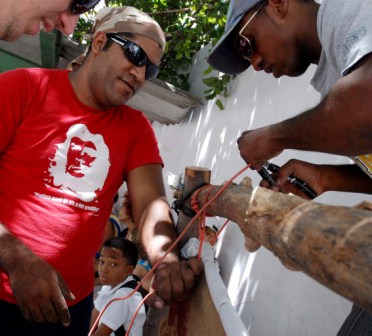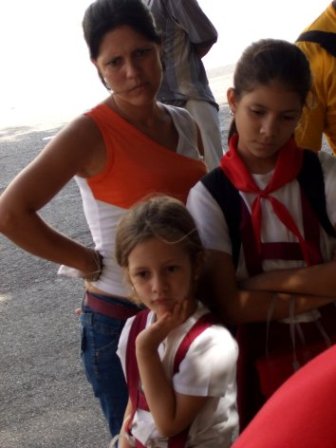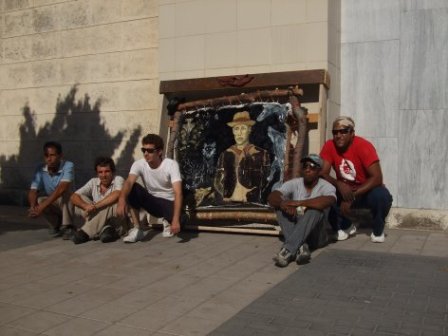Artists Homage to Joseph Beuys
Text and Photos By Irina Echarry

HAVANA TIMES, May 23 – “Every human being is an artist.” With this conception of life and art, Joseph Beuys aroused commotion, debate and many contradictory opinions in his native Germany during the seventies and eighties. His vision radiated around the world.
A small group of artists recently paid homage to him in Cuba.
Federico Garcia, Leafar Delgado, Yoisel Alarcon, Romárico Montero and Luis Eusebio Coto gathered at a bus stop in front of the National Fine Arts Museum (the Cuban Arts building) determined to create a different kind of celebration.
Before arriving at that point, however, many things had to happen. An entire year was spent gathering information and important items: the music that in some way had to do with his body of work, an electric piano, toys, wooden stumps, scraps of animal skin cut from hand bags, cables, hats, and other things.
Then they prepared a kind of outdoor studio-workshop where they set up the picture frame, put the exhibit together and spent the day working, interacting with the public as they came by.
Leafar Delgado spoke on behalf of the group:
Why a bus stop?

The place was chosen in memory of one of Beuys’ works: “The Streetcar Stop” (Venice biennial, 1976) in which the artist recreates moments from his youth. We tried to do something similar to his artistic actions. We identify closely with the group Fluxus, which the painter belonged to. They aimed at eliminating the borders between life and art and in addition to painting they held performances, set up installations, made videos, etc.
The majority of those who are looking at his works now aren’t familiar with the artist. What do you tell them when they ask?
Joseph Beuys was born on May 12, 1921. As young people, we are paying homage to a conceptual artist with a wide range of ideas mostly regarding human beings and their relation to nature. This was influential in the Cuban artists’ movement, especially at the end of the seventies and during the 80s. Painting him is one way of getting to know him a little better, and to come a little closer to his life and his work. People enjoy finding out about him: when we tell them that he spent a week shut in a cage with a coyote, or that he liked medicine, they find it very amusing.
Have you held these activities on other occasions?
This is number 15. A good number, isn’t it? We have done homages to John Lennon, Basquiat, Marilyn Monroe, and Andy Warhol, among others. Also, to the Cuban poet Juan Clemente Zenea, an interesting figure in our literary history.
Do you believe that contemporary Cuban art should reflect the reality we live in?

With elements that represent Beuys’ life, the work came to a close after nailing a hat into one end of the frame. An airplane recalled the accident that the painter suffered during his time as a pilot: he crashed in Crimea (Ukraine) and just when he was close to freezing to death some natives saved him by wrapping him in suet and felt.
The piano mechanism that extends from the rear of the frame was playing a melody of Eric Satie, the French musician that Beuys adored. A leather shirt, the material he utilized in almost all of his work; a dragon that invites us to journey through his childhood dreams.
Everything indicates that the art of Joseph Beuys has had a strong impact on Cuban artists and on the public that views it. The energy of the Fine Arts Museum has helped facilitate this effort. The work will be kept until January 23, the date of the painter’s death. On that day, the video made during this activity will be shown in the Arts and Letters Department to encourage debate among students and professors.
Click on the thumbnails to see all the photos in this gallery














